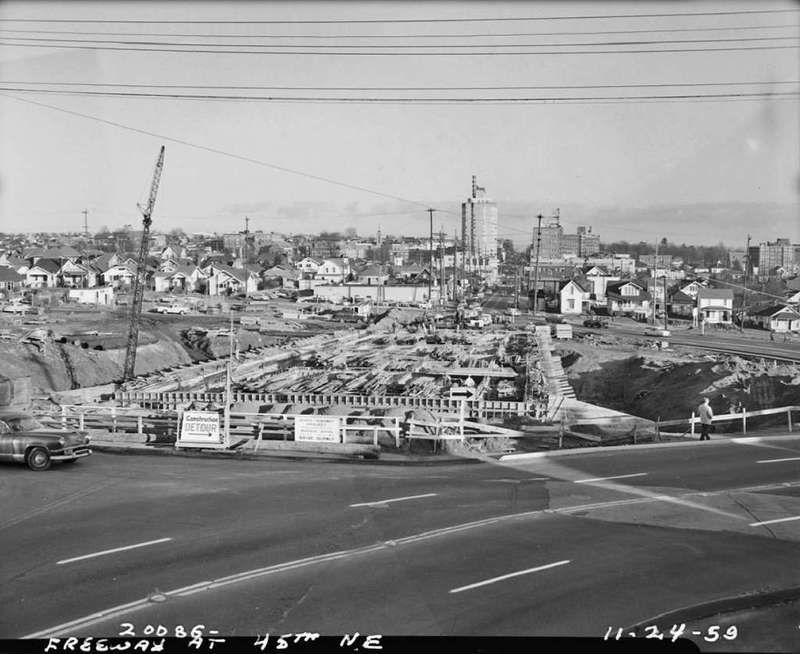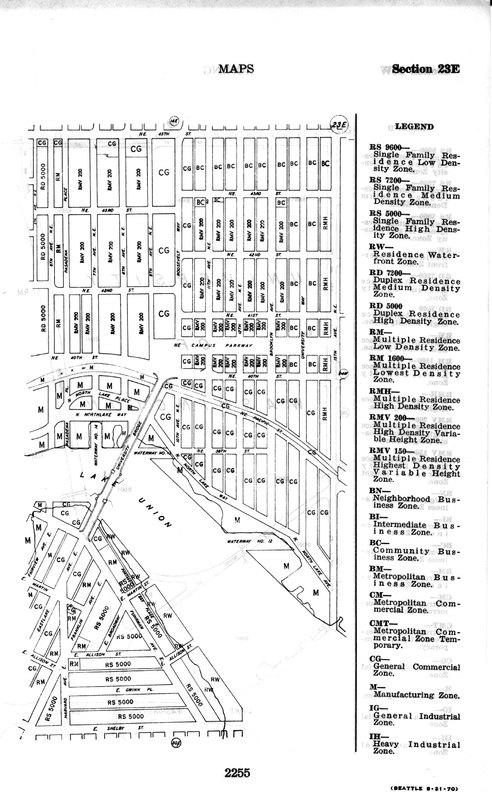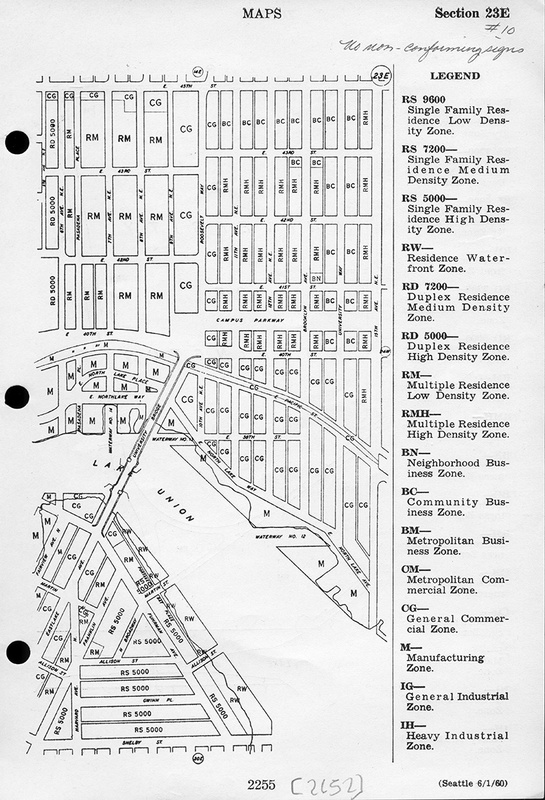Site Report 3: The Audio Tour

Construction of Interstate 5 at NE 45th Street. University District (Seattle, WA). Taken November 24, 1959. Seattle Municipal Archives, Photograph Collection.

Zoning map of the block from 1973. University District (Seattle, WA). Seattle Municipal Archives.

Zoning map of the block from 1960. University District (Seattle, WA). Seattle Municipal Archives.
Recorded audio tour of the story of the block over time. Recorded February 16, 2017.
The development of the block between 7th Ave NE and 8th Ave NE and NE 45th St and NE 43rd St is subtle, yet significant. In 1894, there was generally not much development in the University District. However, looking at a topographical map, in the area that would later become this block we see a small cluster of black squares indicating a group of buildings. Most likely this was a settlement of houses, as shops and places of commerce tended to be closer to the railroad line and main street. This settlement marks the start of the block’s development as a residential neighborhood.
15 years later the block is no longer a stand-alone clump of buildings, but part of a grid of blocks in a growing city. Jumping forward to 1960 we see from a zoning map (pictured at left), the block has been officially zoned as a multiple residence low density zone. The section of the block facing NE 45th St is zoned as a general commerce zone. This side of the block experiences the most change in terms of its zoning and the types of buildings that are there. In 1973 we see from an updated zoning map (pictured at left), that the multiple residence low density zone has been replaced with a multiple residence highest density variable height zone. This shift in zoning reflects the rapid increase in population and development of the block. The block is shifting from low density single residence homes, to the higher density multi-story apartment and residential buildings that we see today. Later, the section of the block off 45th St will be converted into a parking lot to accommodate for the influx of cars to the area because of the newly constructed freeway.
The National Interstate and Defense Highways Act of 1956 had a major impact on this block. Signed by President Eisenhower, this act established a highway system throughout the United States including the construction of Interstate 5 that borders this block. The National System of Interstate and Defense Highways passed both the House and Senate on June 26, 1956 and on June 29 was signed into law. Immediately, Washington State sought funding to begin construction of the Seattle freeway (Becker 1). The first segment of I-5 was formally opened in Tacoma on December 1960 and was completed in 1967 (Dougherty 1). The construction of I-5 disrupted the residential life of the block as a massive federal construction project was taking place right next to people’s homes. Although nothing on the block itself had to be torn down, the dirt and noise from the huge federally funded project was a general disturbance to the residents. After the Interstate’s completion, residents of the block would reap the benefits being so close to the freeway, yet also have to deal with the rush hour traffic of a rapidly growing city. Although this freeway was built after the New Deal era, it still reflects, represents, and fulfills the ideals of Futurama and the "futuristic" city centered around cars that Professor O'Mara outlines in Lecture 12. With the construction of I-5 that runs all the way from the Mexican border to the Canadian border, Futurama is realized. While freeways did not decongest the city as people thought they would, the completion of I-5 in Washington solidified the car-centered city. In some cases, freeways or highways were built as barriers between different communities and used as tools of segregation. Because the construction of I-5 near the U District and in Washington was part of a much larger national project, it was not used as a tool for segregation as it was not a local project.
Today, Block 1 is home to many students of the University of Washington. They live in the multiple apartment buildings and rental home that are on the block. On any given weekday bus 44, the bus that runs from campus to near block 1, is full of students travelling to and from school. With parked cars lining the streets and students walking to and from school, the block has kept the neighborhood feel that it has carried since it beginning.
